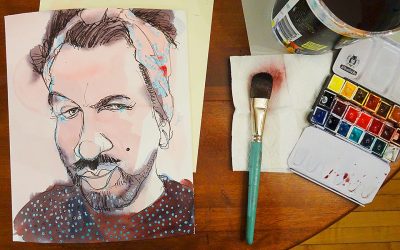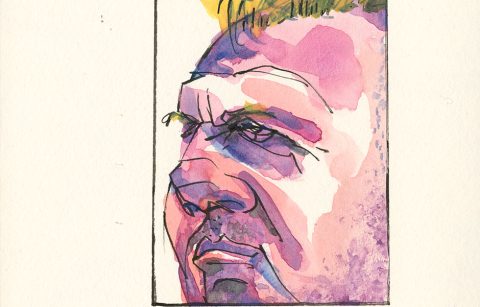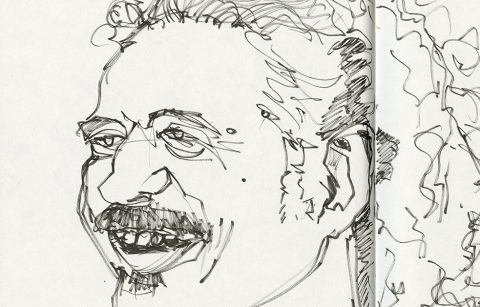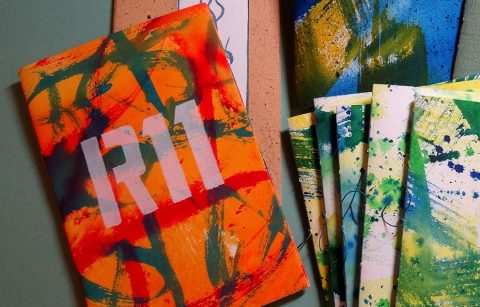
If you paint in watercolor, inks, or acrylics, chances are at some point you’ve tried to mask something off so that you could retain the white of your paper, or an earlier color that you had laid down.
Artists use lots of products for masking—tape is the obvious one, especially if you want to create a frame or straight edges (or you tear or cut the tape for more unusual edges!). You can often get away with simply putting a Post-it Note over something before applying paint.
But masking fluid is also a useful supply to have on hand.
There’s one problem—most masking fluids have strong odors (think ammonia). They also tend to ruin the brushes and tools you use to apply them to your painting.
If you would like to try using masking fluid without the mess and fuss I recommend the Molotow Grafx Art Masking Liquid Pump Marker. It’s a marker (available in 2mm or 4mm tip sizes) filled with masking fluid that is so low odor even I can work with it.
It’s also low mess because the masking fluid comes already loaded inside the application tool. Just shake it up, pull off the cap, pump the tip a bit and you are writing, sketching, and marking with the masking fluid.

The fluid comes out with a light blue tint that helps you see whether or not you have the coverage you need and where that coverage is!
Simply let the liquid mask dry completely and apply your paints.
When you want to expose your reserved areas simply rub the dried masking fluid with your finger to get it to ball up so you can brush it off your painting surface. (Or you can use a rubber cement pick-up.)
This handy tool is portable so you can have it out and about with you when you’re sketching.
Keep the following in mind:
Always test on your paper/painting surface before using in your painting. Soft papers like some textured drawing papers or printmaking papers are not great candidates for use because the dried masking fluid tends to pull up the fibers of those papers when you remove them after painting. Watercolor papers with their surface sizing are ideal.
Always let the fluid dry completely before you try to remove it, or you can end up tearing your paper.
Always let your PAINT dry completely before you try to remove your masking fluid. If the paper surround the mask still has damp paint on it you might tear the surface of your paper as you rub to remove your mask.
When the masking fluid dries take a close look for pin-holes in your mask coverage. Add additional mask before painting. If you can see the paper then paint is going to get through.
It’s generally considered a good idea to leave masking fluids on your paper for as short a time as possible. If you finish your painting on your sketch out, remove the mask when that painting is dry, or later that evening. If your habit is to work for weeks on a painting, then trial and error will tell you how long is safe to leave the mask on a given paper. I suggest you run some timed test strips on the type of paper you’re going to use so you don’t ruin a painting you’ve slaved over for hours.
If you want to find a traditional liquid mask to apply with syringes and brushes but can’t stand odors, check out Schmincke’s Rubbelkrepp, which is an ammonia free liquid mask. You’ll still have to deal with gummed up brushes and tools but you’ll have even more control over the application, and no odor issues.
(If you do elect to use a brush it goes without saying you’ll want to use old brushes, or buy cheap brushes specifically designated for this task. I have found that if I wet my brush first and move the tip over a bar of Ivory soap and then dip it in the masking fluid I have an easier time cleaning the brush out. I never dip this treated brush into my jar however, but pour out a little bit of the masking fluid into a small cup, so that I don’t contaminate the jar with Ivory.)























Brilliant! What a great idea. Thanks for telling us about it. Love the painting too!
Adrianne, I hope that you can find one and incorporate it in your sketching practice. Have fun. Thanks for writing!
Roz, do you know of a source for the Schmincke Rubblekrepp in the US?
Yes, I purchased my last bottle of this at Wet Paint in St. Paul. They do mail order. It’s still on their website http://www.wetpaintart.com/schmincke-liquid-frisket-20ml.html
Hope that helps.
Thank you for this information. I am most appreciative off all that you share.
Thanks Sheila, glad it’s helpful.
great post-very helpful!